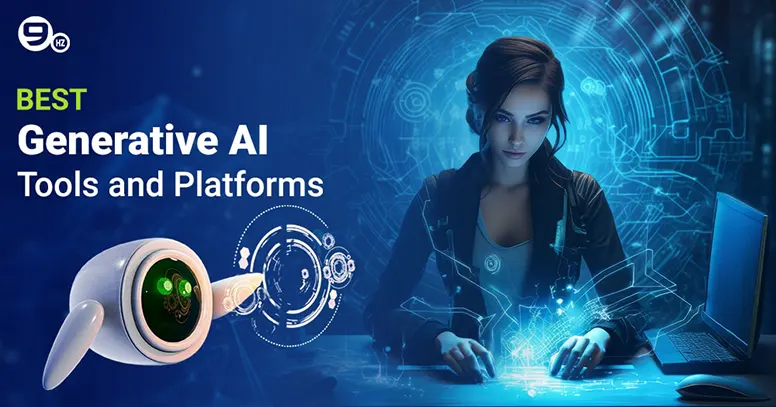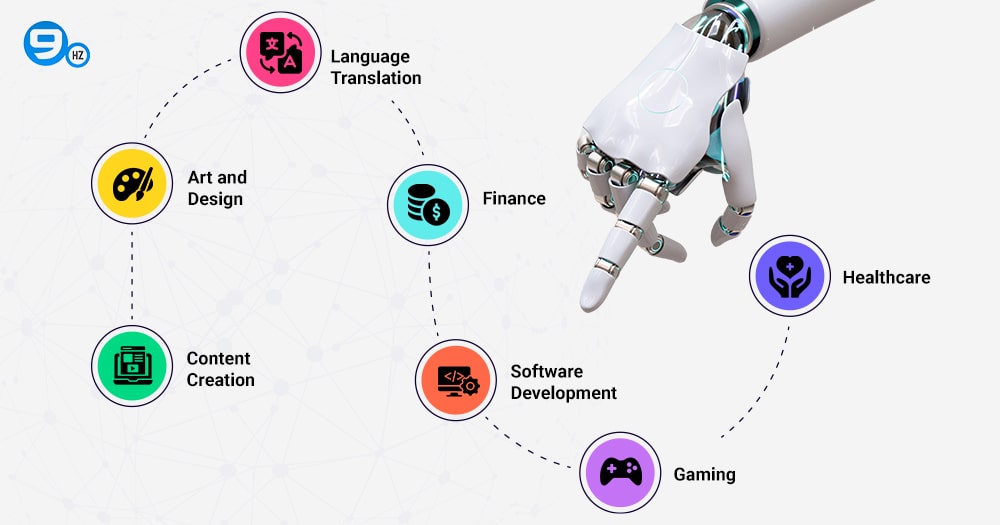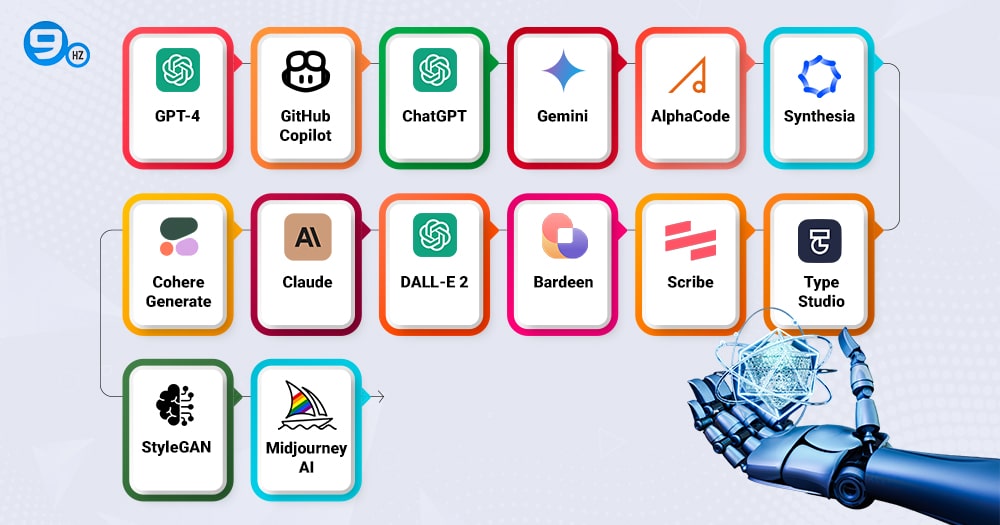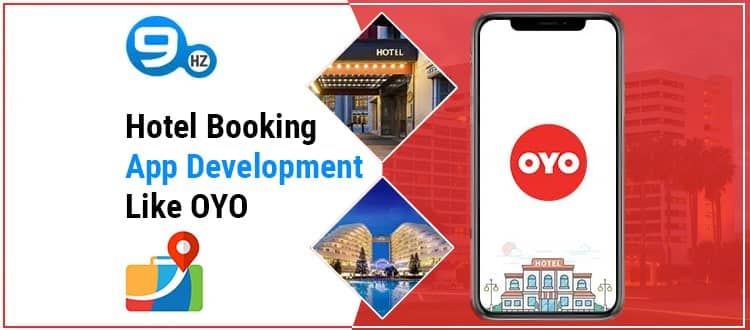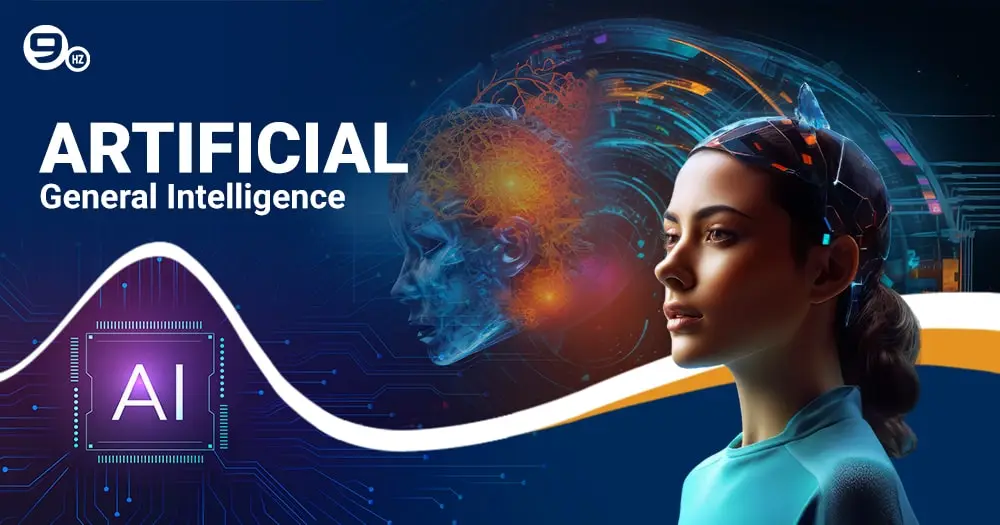There are many popular generative AI tools like GPT-4, Chat GPT, Google Bard (Now known as ‘Gemini’), Scribe and DALL-E-2 that are reshaping the AI world and offering solutions to content creators like never before.
With each day, Artificial Intelligence is penetrating our day-to-day lives. As a technology, it is continuously evolving and transforming various sectors. In 2024, Generative AI has emerged as a promising technology reshaping the world of content creation with innovation and problem-solving.
As per a report published in Bloomberg Intelligence, the demand for generative AI products could grow up to $280 billion in revenue by 2032. The report further states that the demand for generative AI might expand at a Compound Annual Growth Rate (CAGR) of 42%.
This blog will throw light on some of the best Generative AI tools and platforms that can be used to supercharge progress. So, without any further ado, let’s dig in!
But first, let’s start from the basics and then we’ll jump on to the advanced part!
What is Generative AI and its Significance?
Generative AI in simple words is a subset of Artificial General Intelligence that has the power to create vivid content such as text, images, audio files, and videos, alike to its training data. The systems within the tool absorb the existing information in order to create fresh and unique content.
Its significance stems from its caliber to revolutionize industries across the board. Generative AI tools are revolutionizing everything from content creation to software development by bringing more creativity, efficiency, and innovation. Industries are rapidly leveraging these AI tools for streamlining their processes, reducing manual efforts, and, unlocking new opportunities that were never seen before.
The Future of Generative AI Tools
The future of generative AI is quite promising across numerous fields. With its continuous evolution, AI models can generate human-like text, art, music, and even code, redefining creativity and productivity. The integration of generative AI in daily workflows enhances efficiency by automating routine tasks and providing innovative solutions to complex problems.
For example, in the healthcare sector generative AI could analyze vast amounts of medical data to create personalized treatment plans, while in education, it could offer tailored learning experiences based on the needs of individual students.
Moreover, the rise of multimodal AI systems promises more cohesive and immersive experiences with their ability to process and generate content across diverse media types. These systems have the potential to revolutionize industries like entertainment & media, where AI-generated films, games, & virtual worlds become more sophisticated and engaging.
Ethical considerations and governance will also redefine generative AI’s future. Ensuring ethical AI development and usage will be vital for addressing issues like intellectual property, misinformation, and job displacement. Collaborative efforts among governments, technology companies, and academia will be crucial to creating frameworks that strike a balance between innovation and societal impact.
In a nutshell, the future of generative AI is aimed at expanding human capabilities, offering extraordinary opportunities while also breeding challenges that require careful navigation. A generative AI development company will play a pivotal role in this evolving landscape, ensuring that the advancement of AI technology aligns with ethical standards and societal needs.
How Does Generative AI Tool Work?
Generative AI tools are supported by machine learning models that work in the backend. These are often called deep learning models such as variational autoencoders (VAEs) or generative adversarial networks (GANs). The data set helps the model to learn various patterns and relationships.
The human-created content usually forms the datasets, therefore generative AI tools can be trained by programmers to perform all the tasks. For instance, an image can be created in the style of a specific artist, or an essay can be written following a particular writing style. These generative AI tools can mimic the already existing data to provide you with the desired results.
Having said that, it also indicates that these tools have a certain limitation in terms of creativity. They are not designed to give you results related to the subjects on which they are not trained. Hence, there are chances that you may find the results occasionally inaccurate and repetitive.
How Can Businesses Use Generative AI Tools?
Businesses can use Generative AI tools and platforms in multiple areas like:
1. Content Creation
Writers, digital marketers, and content creators can utilize generative AI tools for automating content generation. This ultimately helps in streamlining workflows and reducing a significant amount of time for creators. All this brings more efficiency allowing the writers and marketers to spend more time in creative fields and other strategic areas.
2. Art and Design
Artists and designers are exploring their creative sides by using generative AI tools for creating unique forms of art like illustrations, designs, and visual art. According to a study, the design process with generative AI led to a phenomenal increase of 75% in the number of unique and attention-grabbing design concepts.
3. Language Translation
Break all the language barriers by using generative AI tools that translate text and speech in real-time. This brings more efficiency by streamlining communication across varied languages. With these tools, translation accuracy reaches 95%, fostering global collaboration and understanding.
4. Finance
Financial institutions like banks are also capitalizing on these AI tools for market analysis like stocks, shares, bonds, etc. Their predictions are highly accurate and in future the they will dominate the market as everyone will eventually shift to these tools for more profitability and better investment decisions.
5. Software Development
Code is being written in a new way thanks to generative AI. It assists software developers by generating code snippets, removing bugs, and suggesting optimal solutions to various coding obstacles. All these features greatly help in getting development faster with better quality of code.
6. Gaming
Gaming is one of the largest sectors influenced by Generative AI. Game developers are using generative AI for creating immersive virtual worlds, generating innovative in-game content, and transforming gameplay according to the user’s behavior. This takes user engagement to the next level, maximizing the overall experience of gaming.
7. Healthcare
From analyzing medical images to diagnosing diseases, generative AI does it all in the field of healthcare. Radiologists while analyzing images using generative AI reported 20% improvements in accuracy while detecting subtle anomalies. This leads to more efficiency as diagnosis can be performed in less time and with more accuracy.
With the advancement of generative AI, its application across all these industries is anticipated to become more sophisticated revolutionizing the medical sector to its core.
Top 15 Generative AI Tools and Platforms
| Tool Name | Company | Ideal For | Use Cases | Pricing |
|---|---|---|---|---|
| GPT-4 (ChatGPT) |
OpenAI | Best LLM and Content Generation Platform | Content Generation, Large Language Model, Chatbot | · ChatGPT: Free · GPT-4 Input: Starting at $0.03 per 1,000 tokens |
| GitHub Copilot | Microsoft/GitHub/OpenAI | Ideal for maintaining code quality | Code production, code editing | · Individuals: $10 per month, or $100 per year · Business: $19 per user, billed monthly |
| Synthesia | Synthesia | Ideal for AI generated videos and avatars | Video creation, AI Avatar Creation | $22 per month, billed annually |
| Midjourney AI | Midjourney | Best for AI Image generation and editing | AI powered Image and art generation | $8 per month, billed annually, or $10 billed monthly |
| Claude | Anthropic | Ideal for business related content generation | Chatbot, AI Assistant, Large Language Mode (LLM), Content Generation | A free to use tool |
| DALL-E 3 | OpenAI | Best for Accessible Image Generation | Image and Art Generation | · App embed: Starting at $0.04 per image · Via ChatGPT Plus: $20 per month |
| Cohere Generate | Cohere | Ideal for straightforward API integration | Business AI, Large Language Model, Content Production | · Playground: Free, limited access for non-production use cases · Input: Starting at $0.30 per 1 million |
| Midjourney AI | Midjourney | Best for Advanced AI Image generation and editing | Image and artwork generation | $8 per month, billed annually, or $10 billed monthly |
| Gemini (formerly Google Bard) | Best for ethical and transparent AI development | Chatbot, Code Debugging | · Business: $24 USD per user · Enterprise: $36 USD per user · AI Meetings and Messaging: $12 USD per user |
|
| Scribe | Scribe | Good at creating reports, summarizing papers, and crafting guides | Content Creation, Image Editing, Adding Text Animations | · Basic: Free · Pro Team: $12 / seat month · Pro Personal: $23 / seat month |
Here is the list of the 15 best generative AI tools in 2024
1. GPT-4
GPT-4 is the latest milestone of OpenAI’s Generative Pre-trained Transformer series. It has no comparison when it comes to natural language processing. The reason for its versatility lies in its ability to understand the context, intricacies, and nuances of various industries. If you are a content creator, you just cannot ignore the sheer power GPT-4 brings to the table in the form of clear and natural-looking text. Businesses on the other hand find it extremely useful when it comes to customer support, chatbots, and automated content creation.
Key Features:
- Works on more than 100 trillion parameters
- Enhanced factual performance
- Multilingual Capabilities
- Human-level performance on various parameters
- Enhanced Steerability
- Cost-effective and scalar
2. GitHub Copilot
Collaborative coding has gained unprecedented momentum in recent times, thanks to GitHub Copilot. GitHub Copilot is an AI-powered coding assistant that was developed in collaboration with OpenAI. It has the ability to understand the intent behind the code which helps in generating real-time suggestions. This is a collaborative approach that helps in two ways – first, it accelerates coding-related tasks, and second, it enhances the knowledge among the developers. GitHub Copilot is a great example of how generative AI can promote teamwork and efficiency in software development.
Key Features:
- Smart and intelligent code suggestions
- Multilingual and open source
- Integration with IDEs
- Autocompletion for documentation and comments
- Collaborative Coding
3. ChatGPT
ChatGPT, a brilliant product of OpenAI has opened the doors for AI manifestation. It works on sophisticated language models that help in creating contextually aware text. These points make ChatGPT an ideal choice when it comes to products like virtual assistants, customer service applications, and in cases where natural and human-oriented conversation is happening. ChatGPT can easily understand and respond to user inputs with more consistency to provide a seamless user experience.
Key Features:
- Natural language understanding
- Language fluency
- Creative writing Text completion and suggestion
- Open-domain conversations
- Text completion and suggestion
4. Gemini (Formerly Google Bard)
Bard has emerged as a game changer in the field of content creation. It can easily generate content that is relevant and contextually relevant. Whether it’s drafting job applications, writing essays, or creating creative content, Bard leverages AI in such a way that it takes human creativity to a whole new level. The application of this generative AI tool is quite diversified and caters to multiple sectors like advertising & marketing, entertainment, media, and so on.
Key Features:
- Built on LaMDA, a transformer-based model
- In-built rating system for user responses
- Accessible through individual Google Accounts
- Assists with tasks concerning programming and software development
5. AlphaCode
AlphaCode is a proven authority in the coding realm providing programmers a gateway to generate code snippets. Due to its ability to understand coding structures and programming languages, it can assist developers in solving a diverse range of coding tasks. From offering suggestions to coders to helping them solve programming logic and algorithms, AlphaCode does all with ease. Alphacode has the power to maximize the productivity of developers at large.
Key Features:
- Transformer-based language model
- Smart filtering for large-scale codes
- Programming capabilities in multiple languages
- Datasets and solutions are available on GitHub
- Large community size
6. Synthesia
With AI-driven video production, creative content creation has touched new heights, thanks to AI tools like Synthesia. Synthesia combines realistic avatars with AI algorithms, allowing users to generate lively video content without the need to shoot with real people. In industries like marketing where fresh content is needed every single day, Synthesia proves to be a game changer as content can be produced rapidly and deployed the same day.
Key Features:
- Turns text into a realistic video with AI-generated characters.
- Creates educational videos with different avatars explaining complex concepts
- Personalized video generation capabilities used for special occasions
- Engaging and realistic visual storytelling
7. Cohere Generate
Cohere Generate is yet another brilliant tool that beautifully generates and summarizes content to help content creators at large. The tool is enriched with natural language process functionality that helps in distilling complicated information into concise and coherent summaries. This tool is useful to those industries where processing data and information is critical. For example, in fields like research, journalism, and data analytics, the application of this tool can do wonders as it has the ability to automate the process of content summarization.
Key Features:
- Compatibility with Python, Shell, and Node Languages
- Compatible with private, public, and hybrid cloud environments
- Designed for diverse natural language generation
- Capable of crafting personalized email content
8. Claude
When it comes to graphic designing and visual content creation, Claude stands alone. Designers can create eye-catching graphics, designs, and illustrations with Claude that leverage AI algorithms to create content. It has an inbuilt functionality to understand design principles and adapt to user preferences. That’s the reason Claude is a valuable resource for creators like graphic designers and artists who are looking for something that makes their jobs easy.
Key Features:
- Can accept texts and documents as user inputs
- Available in Slack
- Backend API for developers
- Support multiple languages
- Backend API for developers
9. DALL-E 2
DALL-E 2 is the next generative AI tool on the list that works on the principle of generating images with its advanced capabilities. The successor of DALL-E, DALL-E 2 is capable enough to generate high-quality and visually appealing images based on the text description. People like artists and designers can use this tool to give life to their thoughts. It can be used in areas like advertising and digital media where creativity is needed.
Key Features:
- OpenAI Deep Learning Model
- Text-to-image conversion displays incredible forms of creativity
- Creates multiple forms of art
- Connects the dots of visual and spoken innovation
10. Bardeen
Bardeen is the next AI tool that aids scientists working in the area of data generation and data analysis. Bardeen has advanced capabilities that can be capitalized by scientists to simulate and generate data while performing experiments. This helps in accelerating the pace of scientific discovery. The tool works with the sole purpose of knowledge advancement with its application in various scientific disciplines such as physics, chemistry, biology, and so on.
Key Features:
- Saves time by doing repetitive tasks
- Self-learning feature to create personalized automation
- Works with multiple apps and websites making your task easy
- Used by managers, recruiters, and market researchers widely
11. Scribe
Content creation is revolutionized by Scribe, the AI writing assistant. It effortlessly performs numerous tasks such as summarizing articles, drafting reports, and editing writeups. Scribe excels in tailored tasks to aid writing that boosts productivity. A significant amount of human touch is necessary in order to get the desired results.
Key Features:
- Virtual AI writing assistant
- Creates content in numerous styles and formats /li>
- Creates reports, summarizes articles, and helps in academic writing
- Simplify documentation and help in training
- Widely used in research and content creation
12. Type Studio
Type Studio is a platform where video editing through text can be done. Type Studio can benefit content creators in various ways. It provides tools to edit and beautify video content with text overlays, captions, and animations. So as a video creator, if you want to create engaging and accessible content for multiple platforms, Type Studio is for you.
Key Features:
- Automatically generates subtitles and closed captions
- Text is transcribed with just a single click
- Users can easily add subtitles to edited videos
- Stores footage online
- Cloud video rendering
13. StyleGAN
When it comes to realistic image generation, StyleGAN stands alone as an undisputed champion. It beautifully generates high-quality and realistic images with fine details and vivid styles. Nowadays this tool is widely used in industries such as fashion, media, and entertainment where images play a high role. StyleGAN can benefit creators by creating stunning images that can be used in their crafts making them visually appealing.
Key Features:
- Generates high-quality and realistic images
- Largely used for portraits and artwork
- Allows control over specific visual features
- Capable of generating images of diverse photorealistic features
14. Midjourney AI
Midjourney is a revolutionary AI tool that blends art and tech. First, you need to describe what you want and based on what you have written it generates stunning pictures. The algorithms on which it is based turn words into unique artworks. It is backed by machine learning algorithms that help in interpreting and analyzing the data which could be in various forms such as text, audio, or image. Based on the patterns found in the data, the algorithms generate new images, sounds, or other media files.
Key Features:
- Customize artistic processes as per users
- Easy transition from idea to visualization
- Excellent choice for rapid iterations
- Generates eye-catching images and visuals
15. Designs.AI
Designs.AI helps you produce logos, videos, banners, and, posters, using AI within a few minutes. The platform helps in workflow simplification which ultimately saves time and reduces costs. Designs.AI is an AI platform that utilizes artificial intelligence for the purpose of creating, editing, and scaling content efficiently. In a nutshell, Designs.AI is a tool that is built for those who are searching for an all-in-one AI design tool that can take care of multiple aspects of content creation. If you’re considering the cost to develop an AI app, Designs.AI offers a comprehensive solution that maximizes efficiency and minimizes expenses.
Key Features:
- Ideal for logo and video-making
- Creates realistic and eye-catching designs
- Advanced functionalities like speech maker and graphic painter
- Color matcher feature to create matching color theme graphics
Generative AI vs. AI
Both AI and generative AI are powerful technologies that are reshaping businesses by cutting down their costs and optimizing their operations, provided it is applied correctly.
In simple words, Artificial Intelligence (AI) can be compared to a strategist that is well informed and excels at analyzing days and making decisions. Generative AI on the other hand is similar to an artist that creates fresh and creative content.
Here are the key differences between the two technologies in the form of a table:
| On the basis of | AI | Generative AI |
|---|---|---|
| Functionality | Performs a variety of tasks requiring human intelligence | Generating New and Fresh content |
| Focus | Prediction of future events based on analytics | Creativity and imagination help the tool to generate completely unique forms of art |
| Use of patterns | Discover patterns to make predictions | Discover patterns for combining them in new and original forms |
| Innovation and Creativity | Lacks creativity but excels at analytics | Good at the creative side |
| Learning Approach | Supervised/unsupervised/semi-supervised/reinforcement learning | Reinforcement learning based on user feedback |
| Computational Resources | Amount of resources depend on the model size | Complex computation due to the large size of the models |
| Training Dataset Size | Models can be smaller; hence the dataset can also be smaller | Due to the large size of models, the datasets can be large |
| Accuracy level | Standards are set for what’s correct and what’s not. Hence, the results are verifiable at large. | Here, human interpretation decides the level of accuracy. What is good for one person may not be as good as for another. |
Conclusion: Generative AI Tools
This is the best time when something like Generative AI has penetrated the tech world that is witnessing the possibilities of machines actually contributing rather than just mimicking human actions. From creating essays to generating code snippets and composing music, this remarkable technology has everything in store for you.
Moving forward, we must acknowledge the fact that Generative AI has both pluses and minus. It needs a human touch for time-to-time corrections and refinements. Having said that, it is imperative not to appreciate the immense power it brings to the table. With these 15 cutting-edge generative AI tools and platforms, businesses are well on their way to conquering unparalleled levels of proficiency, creativity, and innovation.
We at The NineHertz offer unprecedented generative AI consulting services in ways that businesses capitalize on this technology to the maximum level. We understand that combining AI with Human Intelligence can give birth to possibilities that are beyond imagination Our Skilled AI engineers are well-versed in turning your creative ideas into reality. Talk to our AI experts and kickstart your journey with The NineHertz.
FAQ’s: Top Generative AI Tools and Platforms
Q.1 What is the Most Popular Generative AI Tool?
To assess the popularity of a generative AI tool, you must consider all the requirements. Some popular choices are namely OpenAI’s GPT-3 and GPT-4 for natural language generation, Synthesia for videos, and Dall-E2 for image generation. The tool’s application will ultimately decide the best tool for your needs.
Q.2 Is ChatGPT a Generative AI?
Yes, ChatGPT is a one-of-a-kind generative AI tool. It uses predictive technology for creating or revising written products of multiple kinds like code, essays, poems, reports, summaries, and more.
Q.3 Is There a Free Generative AI?
Adobe Firefly is free Generative AI tools for creatives.
Q.4 What is the Difference Between OpenAI and Generative AI?
Generative AI allows users to practice complex skills in a virtually safe environment by creating realistic simulations for training purposes. OpenAI on the other hand would be vital when it comes to ensuring the effectiveness and accuracy of these simulations.
Q.5 Where Can I Use Generative AI?
In the real world, Generative AI has a wide range of practical uses in areas like Content Generation, Data Augmentation, Natural Language Understanding, Design & Creativity, and so on.
Great Together!
